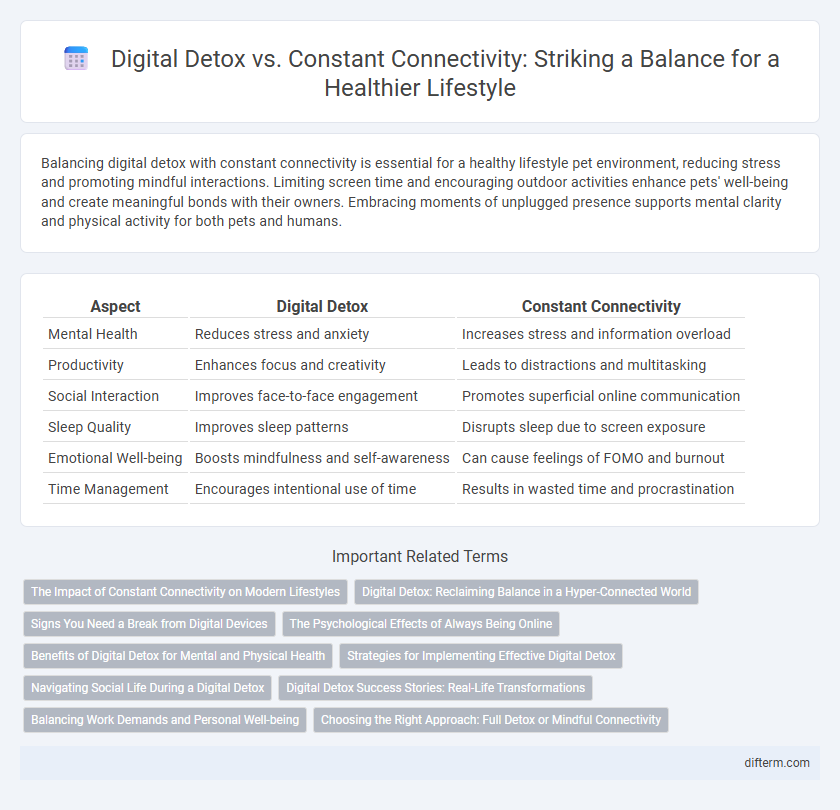Balancing digital detox with constant connectivity is essential for a healthy lifestyle pet environment, reducing stress and promoting mindful interactions. Limiting screen time and encouraging outdoor activities enhance pets' well-being and create meaningful bonds with their owners. Embracing moments of unplugged presence supports mental clarity and physical activity for both pets and humans.
Table of Comparison
| Aspect | Digital Detox | Constant Connectivity |
|---|---|---|
| Mental Health | Reduces stress and anxiety | Increases stress and information overload |
| Productivity | Enhances focus and creativity | Leads to distractions and multitasking |
| Social Interaction | Improves face-to-face engagement | Promotes superficial online communication |
| Sleep Quality | Improves sleep patterns | Disrupts sleep due to screen exposure |
| Emotional Well-being | Boosts mindfulness and self-awareness | Can cause feelings of FOMO and burnout |
| Time Management | Encourages intentional use of time | Results in wasted time and procrastination |
The Impact of Constant Connectivity on Modern Lifestyles
Constant connectivity through smartphones and social media leads to increased stress levels and reduced attention spans in modern lifestyles. The persistent influx of notifications disrupts work-life balance, causing difficulty in maintaining focus and fostering anxiety. Implementing digital detox routines can restore mental clarity and improve overall well-being by minimizing exposure to continuous online stimuli.
Digital Detox: Reclaiming Balance in a Hyper-Connected World
Digital detox practices help individuals reclaim mental clarity and reduce stress by temporarily disconnecting from constant connectivity and digital distractions. Studies show that periods without screens improve sleep quality, increase mindfulness, and enhance interpersonal relationships. Embracing a digital detox fosters a balanced lifestyle essential for well-being in today's hyper-connected society.
Signs You Need a Break from Digital Devices
Persistent eye strain, frequent headaches, and disrupted sleep patterns signal the urgent need for a digital detox. When productivity declines and social interactions become superficial due to constant notifications, stepping away from screens is essential. Experiencing heightened anxiety or irritability in the absence of device use further highlights the importance of taking a meaningful break from digital connectivity.
The Psychological Effects of Always Being Online
Constant connectivity triggers heightened stress levels by overwhelming the brain with nonstop notifications and information, leading to mental fatigue and decreased attention span. Digital detox practices reduce anxiety and improve mood by allowing the nervous system to recover from the dopamine-driven cycle of instant feedback loops. Research shows that limiting screen time enhances cognitive function and promotes better sleep quality, essential for maintaining mental health in a hyperconnected society.
Benefits of Digital Detox for Mental and Physical Health
Digital detox significantly reduces stress by limiting exposure to constant notifications and screen time, fostering improved mental clarity and emotional balance. Physical health benefits include better sleep quality and decreased eye strain, as uninterrupted rest allows the body to recover fully. Embracing periods of disconnection enhances overall well-being, promotes mindfulness, and increases productivity by breaking the cycle of digital overload.
Strategies for Implementing Effective Digital Detox
Implement effective digital detox strategies by setting specific time blocks to disconnect from devices and engage in offline activities such as reading, exercise, or meditation. Designate tech-free zones in your home to reduce constant connectivity and improve mental clarity. Use apps that limit screen time and notifications to support sustained periods of digital abstinence, enhancing overall well-being and focus.
Navigating Social Life During a Digital Detox
Navigating social life during a digital detox requires setting clear boundaries to maintain meaningful offline connections while reducing screen time. Prioritizing face-to-face interactions and scheduling regular meetups helps sustain relationships without relying on digital communication. Embracing mindfulness and active listening enhances the quality of social experiences, fostering deeper bonds amid limited online presence.
Digital Detox Success Stories: Real-Life Transformations
Digital detox success stories reveal profound improvements in mental clarity, reduced stress levels, and enhanced real-world relationships after periods of intentional disconnection from digital devices. Individuals report increased productivity and mindfulness, with many adopting balanced routines that limit screen time while fostering face-to-face interactions. These transformations underscore the importance of digital boundaries in promoting overall well-being amid pervasive constant connectivity.
Balancing Work Demands and Personal Well-being
Balancing work demands and personal well-being requires mindful management of digital consumption to prevent burnout and enhance productivity. Establishing regular digital detox periods helps reduce stress, improve focus, and promote mental clarity by disconnecting from constant connectivity. Integrating technology boundaries with scheduled breaks supports sustained work performance and nurtures overall health.
Choosing the Right Approach: Full Detox or Mindful Connectivity
Choosing the right approach between a full digital detox and mindful connectivity depends on individual lifestyle needs and mental health goals. A full detox involves completely disconnecting from digital devices for a set period to reduce stress and improve focus, while mindful connectivity encourages intentional use of technology to maintain balance without total disconnection. Understanding personal habits and priorities helps in selecting an approach that enhances well-being and productivity.
digital detox vs constant connectivity Infographic

 difterm.com
difterm.com